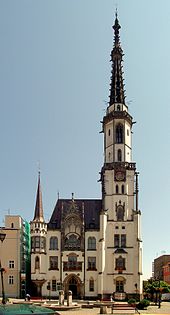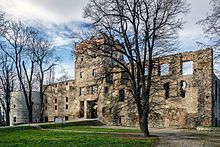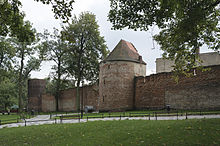Ząbkowice Śląskie
| Ząbkowice Śląskie | ||
|---|---|---|

|
|
|
| Basic data | ||
| State : | Poland | |
| Voivodeship : | Lower Silesia | |
| Powiat : | Ząbkowice Śląskie | |
| Area : | 13.63 km² | |
| Geographic location : | 50 ° 35 ' N , 16 ° 49' E | |
| Height : | 275 m npm | |
| Residents : | 15.004 (Jun. 30, 2019) |
|
| Postal code : | 57-200 to 57-201 | |
| Telephone code : | (+48) 74 | |
| License plate : | DZA | |
| Economy and Transport | ||
| Street : | Wroclaw - Prague | |
| Rail route : | Kamieniec Ząbkowicki – Jaworzyna Śląska | |
| Next international airport : | Wroclaw | |
| Gmina | ||
| Gminatype: | Urban and rural municipality | |
| Gmina structure: | 19 localities | |
| 17 school authorities | ||
| Surface: | 146.88 km² | |
| Residents: | 21,775 (Jun. 30, 2019) |
|
| Population density : | 148 inhabitants / km² | |
| Community number ( GUS ): | 0224053 | |
| Administration (as of 2015) | ||
| City President : | Marcin Orzeszek | |
| Address: | ul. 1 Maja 15 57-200 Ząbkowice Śląskie |
|
| Website : | www.zabkowiceslaskie.pl | |
Ząbkowice Śląskie ( zɔ̃pkɔˈvʲit͡sɛ ˈɕlɔ̃skʲɛ , German Frankenstein ) is a city in the Lower Silesian Voivodeship in Poland. It is the seat of the Powiat Ząbkowicki .
Geographical location
The city is located in Lower Silesia on the Pausebach (Budzówka) , about 65 kilometers south-southwest of Wroclaw on European route 67 . Neighboring towns are Zwrócona (Protzan) in the north, Bobolice (Schräbsdorf) and Kubice (Kaubitz) in the northeast, Jaworek (Heinersdorf) and Stolec (Stolz) in the east, Strąkowo (Kunzendorf) in the southeast, Grochowiska (Grochwitz) and Pawłowice (Paulwitz) in the South, Braszowice (Baumgarten) and Tatnów (Tarnau) in the southwest, Stoszowice (Peterwitz) in the west and Olbrachcice Wielkie (Groß Olbersdorf) and Koziniec (Löwenstein) in the northwest.
history
Frankenstein was founded by the Breslau Duke Heinrich IV. On a property that partly belonged to the episcopal town of Protzan and partly to the Trebnitz monastery village of Zadel. Its location on the so-called Königstrasse, which led from Prague via Glatz to Breslau, favored the development of the city.
Frankenstein was first mentioned in a document dated January 10, 1287. In 1298, Duke Bolko I von Schweidnitz gave the city the right to lay down salt and lead. His son Bolko II confirmed the fishing rights in 1334 and released the city from horse service a year later . In 1321 he founded the Duchy of Münsterberg , to which Frankenstein also belonged. The history of the city is therefore largely identical to that of the rulers of the duchy.
In 1335 the city was besieged by the Moravian margrave and later King of Bohemia, Charles IV . Subsequently, with the Treaty of Straubing on August 29, 1336 , Duke Bolko II placed the Duchy of Münsterberg under the upper fiefdom of Bohemia . 1,346 of Ziębice Duke pledged Nicholas the precincts of Frankenstein the nobleman Heinrich von Haugwitz , two years transferred the lien on King Charles IV later.. On November 9, 1351, Charles IV acquired Frankenstein from Duke Nikolaus and incorporated it into the Glatzer Land as a Münsterberg enclave . The Frankenstein area was thus directly under the Crown of Bohemia . From 1368 to 1465, the office of the Frankenstein governor was held by the respective governor from Glatz. The upper judiciary, which was also acquired in 1351, was exercised by the bailiffs . From 1378 to 1387, both Frankenstein and the Glatzer Land were pledged to the Margrave Jobst , who did not exercise the office of governor and transferred it to authorized representatives. 1388-1397 held the office of governor Stefan Poduška von Martinitz , a favorite of King Wenceslaus IV. After Poduška's violent death, Frankenstein and Glatz were pledged to Duke John II of Troppau-Ratibor in 1397 and administered by his sub-captains. After the death of King Wenceslas, King Sigismund paid off the pledge in 1422 and appointed the East Bohemian nobleman Puta d. J. von Častolowitz as governor of Glatz and Frankenstein.
On March 20, 1428, the city was largely destroyed by the Hussites . After the last Duke of Münsterberg, Johann, died on December 27, 1428 in the battle of Altwilmsdorf , Münsterberg and with it Frankenstein fell to King Sigismund as a settled fief. On August 13, 1429 he pledged the Münsterberg duchy to Puta the Elder. J. and on July 13, 1431 also Glatz and Frankenstein. In 1434 he inherited the Duchy of Münsterberg to him.
After Puta's death in 1434, his widow Anna von Kolditz sold the property to Hynek Kruschina von Lichtenburg in 1440 . He granted Frankenstein two weekly markets in 1441, but was unable to assert himself as a duke among the Münsterberg stalls. Although the Münsterberg estates elected Opava Duke Wilhelm von Troppau as their new sovereign on April 25, 1443 , whose mother was a sister of Duke Johann, who fell in 1428, Frankenstein was on the side of Hynek. After the agreement concluded between Hynek and Duke Wilhelm in 1444, Wilhelm received the Duchy, reduced by Frankenstein, and Hynek Kruschina the soft image of Frankenstein and the Glatzer Land.
After Hynek Kruschina's death in 1454, his son Wilhelm Kruschina von Lichtenburg sold his father's possessions to the provincial administrator and later King of Bohemia, Georg von Podiebrad . He transferred the Duchy of Münsterberg and the Glatzer Land, which he had elevated to a county in 1459, to his sons on December 16, 1465. They divided the inheritance after the death of their father in 1472. The second eldest son, Heinrich the Elder, became Duke of Münsterberg and pledgee of Glatz . Ä. who professed the Catholic faith. His son Charles I was the sole ruler of the duchy from 1511. He dedicated himself particularly to the economic and structural development of Frankenstein. His particular ambition was to rebuild the castle, in which he resided from 1530. After his death, his four sons supported the goals of the Reformation . Because of the debts left to them by their father, they could not complete the palace. After the duchy was pledged, it served as the seat of the royal governors.
Even in the Thirty Years War , the city and its population had to endure destruction and harassment. The castle was blown up two years before the end of the war.
After the First Silesian War , Frankenstein fell to Prussia in 1742 . It rose to become a district town and was connected to the railway in 1858. In the same year the city was destroyed by fire. With the subsequent reconstruction, the character of the city changed due to the advancing industrialization. Around 1900 Frankenstein was still surrounded by a wall, had two Protestant and three Catholic churches, a synagogue , a Progymnasium , a school teachers' college, a monastery of the Merciful Brothers , various manufacturing plants, and magnesite and nickel ore were mined. From 1926 to 1945 the well-known HARO fountain pen factory Hanns Roggenbuck & Co. produced in Frankenstein, which opened another branch in Weißwasser , Czechoslovakia, in 1930 .
In 1945, Frankenstein belonged to the district Frankenstein in district Breslau the Prussian province of Silesia of the German Reich .
Towards the end of the Second World War , Frankenstein was captured by the Red Army in the spring of 1945 and soon afterwards, like most of Silesia, was placed under Polish administration by the Soviet occupying power . Frankenstein received the Polish place name Ząbkowice Śląskie . In the following period, the German population was largely expelled by the local Polish administrative authority . Some of the newly settled residents came from the areas east of the Curzon Line that fell to the Soviet Union .
As from 1946 to 1975, the city was again the seat of a powiat in 1999 .
Provincial governors
During the temporary annexation to the Glatzer Land from 1351 to 1465, the Weichbild Frankenstein had its own governors. Some of them were royal court officials, some held the office only formally in order to increase their prestige, and others were given the office as creditors of the king, who could thereby reduce the debt claims. The office was partially exercised by the Governor of Glatz in personal union, whereby a formal separation was retained: While the Governor of Glatz authenticated with a personal seal, the Frankenstein documents were authenticated with a seal of the Frankenstein Governor.
- 1351–? Rudiger d. J. von Haugwitz
- 1359–1368 Drslav von Krawarn
- 1368–1377 Puta the Elder from Častolowitz
- 1378-1387 Among the men who pledge from Mr. Jobst of Moravia were appointed
- 1388–1397 Stefan Poduška von Martinitz
- 1397–1422 sub-captains who were appointed by the pawnman Johann II of Troppau-Ratibor
- 1422–1434 Puta the Younger from Častolowitz
- 1437–1438 Hašek von Waldstein
- 1440–1454 Pledger Hynek Kruschina von Lichtenburg
- 1454–1458 pledge master Georg von Podiebrad
- 1458–1465 Hans von Warnsdorf , appointed by the pledgee Georg von Podiebrad
Population development
| year | Residents | Remarks |
|---|---|---|
| 1875 | 7,486 | |
| 1880 | 7,861 | |
| 1890 | 8,140 | 1,895 Protestants, 6,103 Catholics and 135 Jews |
| 1900 | 7,890 | mostly Catholics |
| 1925 | 10.093 | of which 2,631 Protestants, 7,393 Catholics, three other Christians and 43 Jews |
| 1933 | 10,472 | of which 2,846 Protestants, 7,511 Catholics, two other Christians and 27 Jews |
| 1939 | 10,809 | of which 3,204 Protestants, 7,367 Catholics, three other Christians and eleven Jews |
| 2002 | 16,495 | |
| 2011 | 16,086 | |
| 2018 | 15,072 |
traffic
Ząbkowice Śląskie station is on the Katowice – Legnica railway line . The Frankensteiner Kreisbahn used to serve the city.
Attractions
- The parish church of St. Anna from the 14th century was rebuilt and expanded several times; 1893-1895 re-gothicised . The colored carved figures (St. Anna, Pietá, Madonna and Child) were made around 1500. Epitaph for Duke Karl I von Münsterberg († 1536) and his widow Anna von Sagan († 1541), who were buried here.
- The 15th century leaning tower to the northeast of the church is the town's landmark.
- The former parish church of St. Georg with hospital was founded in 1319 by hereditary bailiff knights Johannes Secklin and Hermann von Reichenbach . It originally belonged to the Knightly Order of the Holy Sepulcher in Neisse and was the town church from 1538. It has been rebuilt several times. The wall paintings on the southern choir wall date from the 14th century.
- The former Dominican monastery with monastery church from the 14th century was destroyed in 1428 and rebuilt after 1450. During the time of the Reformation it was unused from 1548 and was given to the Protestants in 1576. In the course of the Counter Reformation it was returned to the Dominicans in 1629. After secularization in 1810, the monastery church again served as a Protestant church from 1815. Franciscan convent since 1946.
- The Brothers of Mercy built on their area:
- 1847-1850 from the foundation of Erdmann Joseph Tschirsch a monastery and
- a two-wing hospital in the classical style. It was expanded in 1867 according to plans by the Munich architect Johann Marggraff . Further changes 1899–1902.
- 1867–1870 a church in the style of historicism , also based on plans by Johann Marggraff.
- The neo-Gothic town hall was built between 1862 and 1864 on the site of a Renaissance building from the 16th century that burned down in 1858 and was designed by the Wroclaw architect Alexis Langer .
- The largely preserved city wall from the 13th and 14th centuries was modernized in the 16th century. The castle was included in the fortification area, the trench deepened, the defense towers built and loopholes built in. The former four city gates have been demolished over the centuries.
- The Frankenstein Castle , which was built in the 14th century Ducal Palace, preserved since the 18th century as a ruin.
local community
The following localities belong to the urban and rural municipality of Ząbkowice Śląskie:
- Bobolice (Schräbsdorf)
- Braszowice (tree garden)
- Brodziszów (Dittmannsdorf)
- Grochowiska (Grochwitz)
- Jaworek (Heinersdorf)
- Kluczowa (Kleutsch)
- Koziniec (Lion's Arch)
- Olbrachcice Wielkie (Groß Olbersdorf)
- Pawłowice (Paulwitz)
- Sadlno (Zadel)
- Sieroszów (Seitendorf)
- Stolec (pride)
- Strąkowa (Kunzendorf)
- Sulisławice (Zülzendorf)
- Szklary (Glass Village)
- Tarnów (Tarnau)
- Zwrócona (Protzan)
Twin cities
-
 Červený Kostelec , Czech Republic
Červený Kostelec , Czech Republic -
 Wiesloch , Germany
Wiesloch , Germany -
 Uchte , Germany
Uchte , Germany
sons and daughters of the town
- Christoph Schilling († 1583), humanist
- David Pareus (1548–1622, actually David Wängler), Reformed theologian
- Martin Koblitz (born January 16, 1597 in Frankenstein), rector there (since 1631) and mayor (since 1642), author of a chronicle of the city of Frankenstein
- Benedict Strauch (1724–1803), educator and Catholic theologian
- Karl Adolf von Strotha (1792–1870), Prussian officer and minister of war
- Eduard Herzog (1801–1867), German Roman Catholic clergyman, theologian and writer
- Julius Albert Gruchot (1805–1879), German jurist and lawyer
- August von Stahr (1807–1878), Prussian lieutenant general
- Moritz Graf von Strachwitz (1822–1847), ballad poet
- Adelbert Wölfl (1823 / 1827–1896), painter
- August Friedrich Wilhelm Reissmann (1825–1903), music writer and composer
- Karl Kirchner (1831–1912), military doctor
- Karl Franz Jaeckel (1844–1898), District Administrator in the Strasburg District in West Prussia, member of the Provincial Parliament of West Prussia, member of the Prussian House of Representatives, Governor of the Province of West Prussia
- Friedrich Hammer (1861-1923), German politician (DNVP)
- Benno Jacob (1862–1945), liberal rabbi
- Fritz Erler (1868–1940), German painter, graphic artist and set designer
- Wilhelm Kroll (1869–1939), German classical philologist
- Erich Erler (1870–1946), German painter
- Willi Ost (1903–1945), German SS and police leader
- Alfred Klose (1904–1975), German politician (CDU)
- Eberhard Johannes Albrecht Daerr (1912–2005), Chief Medical Officer of the Bundeswehr
- Franz Toenniges (1923–2008), calligrapher and local history researcher
- Karlheinz Mose (1927–2016), German journalist
- Elmar Bartsch (1929–2010), theologian and speech scientist
- Ursula Höntsch-Harendt (1934–2000), freelance journalist, editor, writer in the GDR
- Günther Knipp (1935–2019), visual artist, draftsman and professor
- Hans-Joachim Daerr (* 1943), former Ambassador of the Federal Republic of Germany to Japan
- Piotr Zielinski (* 1994), Polish football player
literature
- Karl August Müller: Patriotic images, or history and description of all castles and knight palaces in Silesia and the county of Glatz. Second edition, Glogau 1844, pp. 74–79.
- Johannes Athanasius Kopietz : History of German culture and its development in Frankenstein and in the Frankensteiner Land - A contribution to the Silesian cultural history . Breslau 1910 ( online ).
- Hugo Weczerka (Hrsg.): Handbook of the historical places . Volume: Silesia (= Kröner's pocket edition . Volume 316). Kröner, Stuttgart 1977, ISBN 3-520-31601-3 , pp. 95-99.
- Walter Kuhn : German city atlas . Volume III; 3 part band. Acta Collegii Historiae Urbanae Societatis Historicorum Internationalis - Series C. City folder Frankenstein. ISBN 3-89115-003-2 , Dortmund / Altenbeken 1984.
- Pavel Sedláček: Vztahy mezi Kladskem a Frankenšteijnskem ve 14. a 15. stoleti . In: Kladský sborník 2, 1998, pp. 117–123 (Relations between the Glatzer and Frankensteiner Land in the 14th and 15th centuries).
- Dehio-Handbuch der Kunstdenkmäler in Poland: Schlesien , Deutscher Kunstverlag Munich / Berlin 2005, ISBN 3-422-03109-X , pp. 1172–1176.
Web links
- City website (Polish)
- History on frankenstein-schlesien.de
Individual evidence
- ↑ a b population. Size and Structure by Territorial Division. As of June 30, 2019. Główny Urząd Statystyczny (GUS) (PDF files; 0.99 MiB), accessed December 24, 2019 .
- ^ Website of the city (BIP), Burmistrz , accessed on March 13, 2015.
- ↑ Jan Urban: Lichtenburkové. Praha 2003, ISBN 80-7106-579-X , p. 297.
- ↑ a b Meyer's Large Conversation Lexicon . 6th edition, Volume 6, Leipzig / Vienna 1906, p. 832.
- ↑ HARO fountain pen and writing instrument factory .
- ↑ 1926 to 1945 .
- ↑ Company name .
- ↑ a b c d e f Michael Rademacher: German administrative history from the unification of the empire in 1871 to the reunification in 1990. frankenstein.html # ew39fsfrankens. (Online material for the dissertation, Osnabrück 2006).
- ↑ a b c Citypopulation.de [1] .
- ↑ Michael Morgenbesser, Karl Adolf Menzel : Geschichte Schlesiens: Ein Handbuch , Max, 1833, S. 352.









